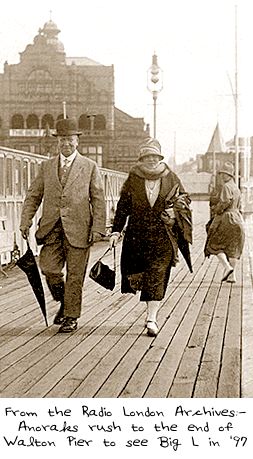

 Dates
– 1st August to 28th August
Dates
– 1st August to 28th August
Frequency – 1143kHz, 262m
During a thunderstorm in the early afternoon, of August 3rd, the Big L transmitter was struck by lightning and knocked down, taking the station off the air for several hours. Further storms were threatened for August 14th, but although the studio was rocked by high winds, the thunder and lightning never materialised.
Radio London's RSL frequency was originally published by the Radio Authority as 1575, but in discussions with the DTI, it was agreed that the station could use 1143. The station could have had 1134 as in '97, which is nearer to 266m for authenticity, but 1143 gives clearer reception, especially at night. The DTI was worried about the use of 1143, because of its proximity to London's TalkRadio, until it was pointed out that the RSL was 60-70 miles from London; Talk Radio barely reaches that part of Essex and Radio London's transmitter was not going to be sufficiently powerful to zap central London! Unfortunately, it appears that TalkRadio transmissions hampered reception in some areas.
Technophiles will be interested to hear that the Big L 2000 mixer desk was a MB15 series 24A. The transmitter was an American rig manufactured by the Harris Gates Corporation.
Clacton Pier Officials were delighted with the RSL attracting visitors to the far end of the pier. They were very excited and supportive of Radio London using the structure as the centre for the broadcast, as 50,000 people visit it every MONTH!
Norman
Barrington selected a new PAMS jingles package that he felt the original station
would have been most likely to choose next, had it not been forced off the airwaves
in 1967. The music on Big L 2000 covered everything from the late Fifties to
the early Seventies and the new package fitted seamlessly into the old favourites.
Great Eastern Railways, sponsors of Big L 2000 weather reports, produced 300 large publicity posters for the RSL. Featuring a photograph of the mv Galaxy, the posters were displayed at every Great Eastern railway station from Liverpool Street outwards, (sixty stations in total). They were also prominent in shop windows around the Clacton area. Destined to become collectors' items, copies of the posters are available for purchase from the Big L 200 website, www.bigl.co.uk. Other posters for sale feature the Big L Top 500, the Summer of Love Chart and a recently rediscovered photograph of the Galaxy.
A schedule for the broadcast can be viewed on a separate page. Weekly Sunday specials featured an original Big L Fab Forty, noon till 3.00pm, The Neil Diamond Hour, 7.00pm to 8.00pm, courtesy of the Neil Diamond Fan Club and 9.00pm to midnight, the Big L Rock 'n' Roll Show.
Big L 2000 was delighted to welcome back original Radio London jocks Ian 'Wombat' Damon, Keith Skues, Alan West and other special guests, John Ross-Barnard, Dave Rogers, Bud Ballou, Peter Young and Alan Hardy. A legal Dutch 600 Watt transmitter on 1584kHz broadcast much of the August 14th output, including the Bud Ballou Show, to the Netherlands and beyond. Sadly, the aerial is directed away from the UK!
The Bank Holiday weekend August 26th to 28th, featured countdowns of both the Summer of Love and Fab 500 charts. Mary Payne appeared with Ray Anderson on an extended Coffee Break Special on August 28th, the final day of the broadcast, talking about the extraordinary story of Chuck Blair, whose whereabouts remained a mystery after the closure of Big L – until now! The show featured studio recordings of Chuck during his Big L days that have never been broadcast before.
During the final hour of live programming, Chris Payne did a sterling job, interviewing loyal Big L supporters braving the cold wind outside the studios. Organisers Paul Graham and Ray Anderson spoke of their delight at having produced a resoundingly successful RSL and of hopeful prospects for Radio London's return. This time, there were no tears at the close-down, but bright hopes for the future.